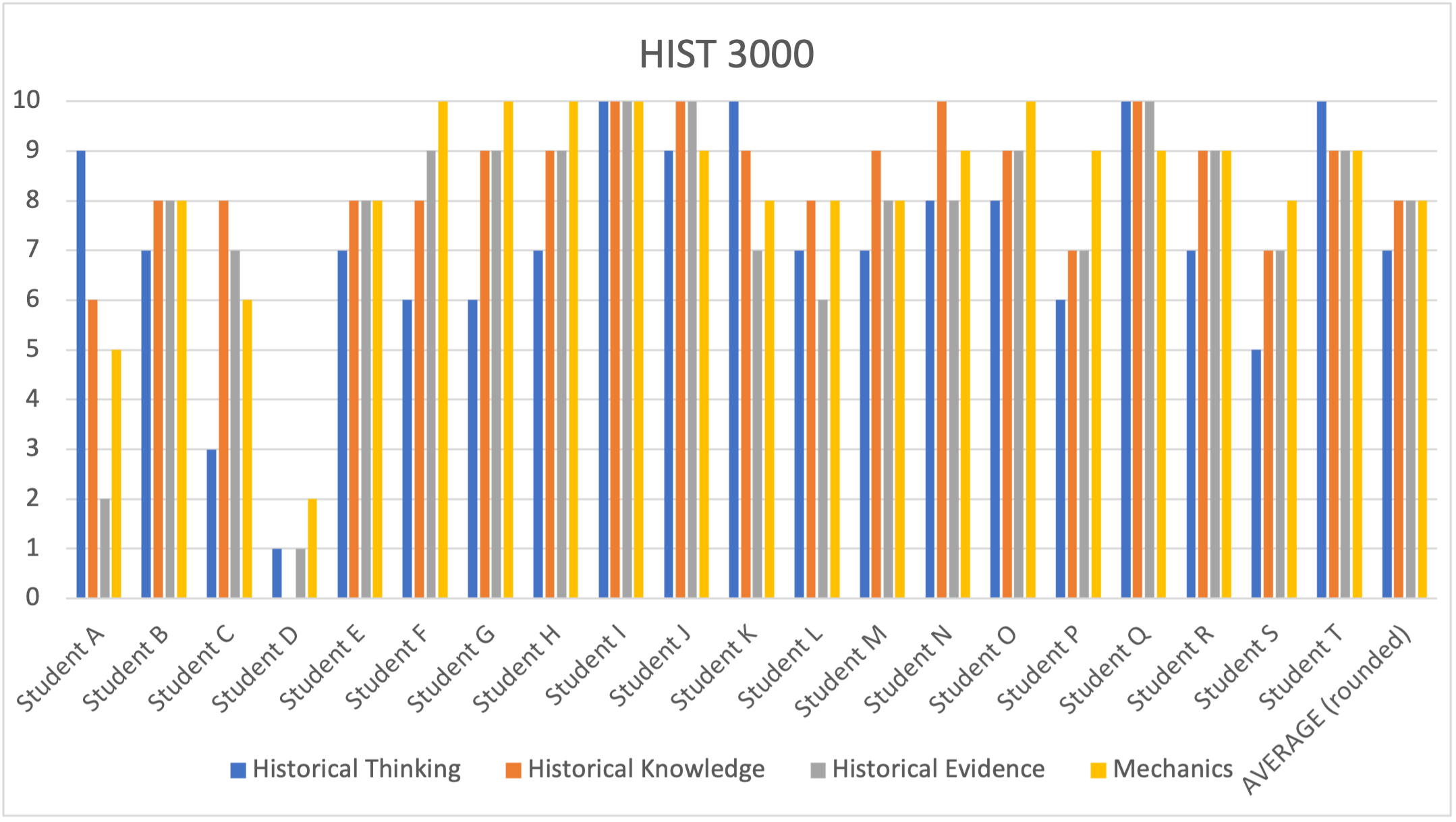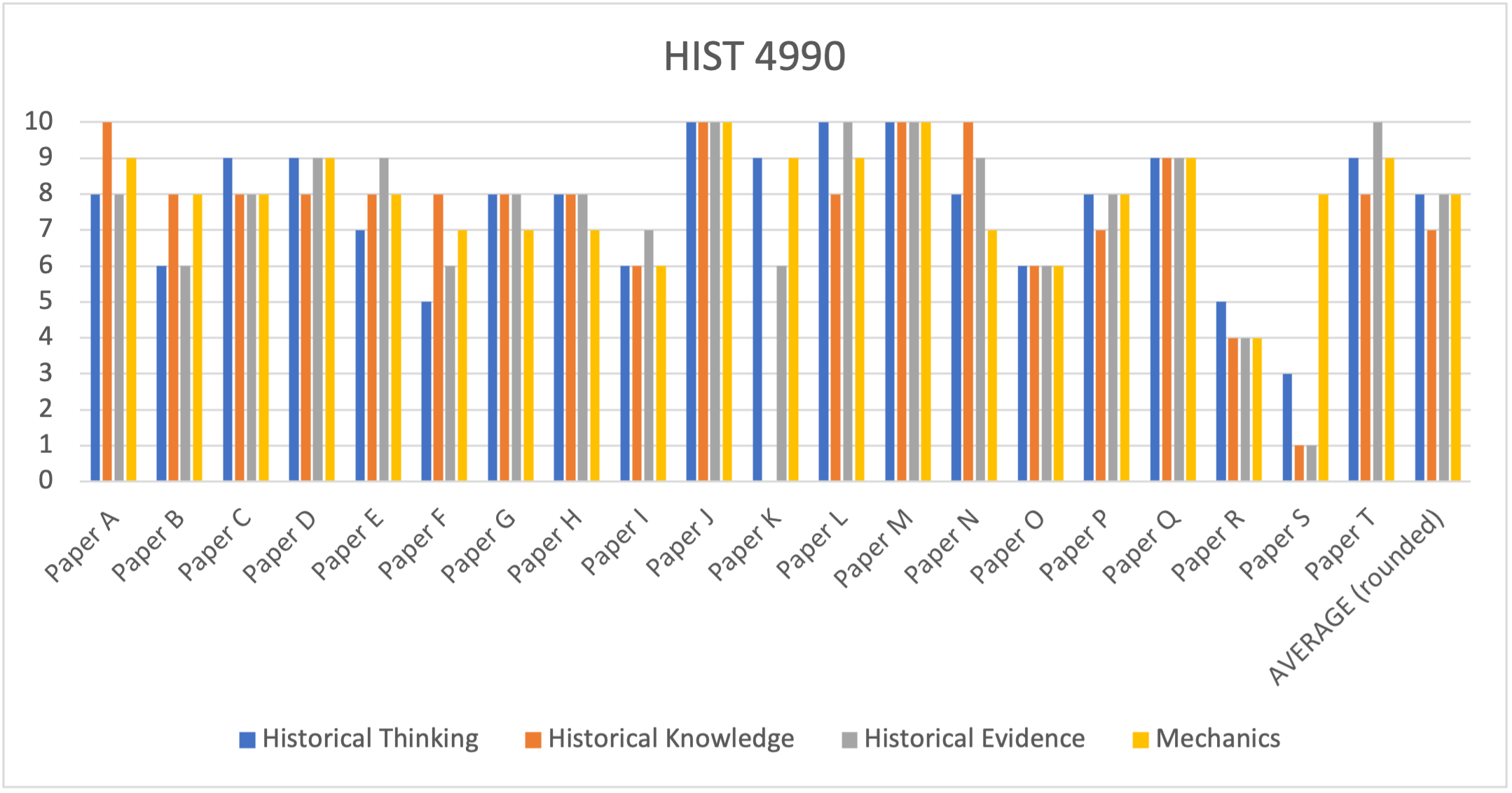Outcomes Data
2021 2020 2019 2018 2017 2016 2015
2022 Outcomes Data
The assessment committee sampled 20 projects (proposals and papers) from HIST 3000 from Fall 2021 and Spring 2022 using new, simplified internal review rubrics.
| Student # | Historical Thinking | Historical Knowledge | Historical Evidence | Mechanics | Total: |
|---|---|---|---|---|---|
| Student A | 9 | 6 | 2 | 5 | 22 |
| Student B | 7 | 8 | 8 | 8 | 31 |
| Student C | 3 | 8 | 7 | 6 | 24 |
| Student D | 1 | 0 | 1 | 2 | 4 |
| Student E | 7 | 8 | 8 | 8 | 31 |
| Student F | 6 | 8 | 9 | 10 | 33 |
| Student G | 6 | 9 | 9 | 10 | 34 |
| Student H | 7 | 9 | 9 | 10 | 35 |
| Student I | 10 | 10 | 10 | 10 | 40 |
| Student J | 9 | 10 | 10 | 9 | 38 |
| Student K | 10 | 9 | 7 | 8 | 34 |
| Student L | 7 | 8 | 6 | 8 | 29 |
| Student M | 7 | 9 | 8 | 8 | 33 |
| Student N | 8 | 10 | 8 | 9 | 35 |
| Student O | 8 | 9 | 9 | 10 | 36 |
| Student P | 6 | 7 | 7 | 9 | 29 |
| Student Q | 10 | 10 | 10 | 9 | 39 |
| Student R | 7 | 9 | 9 | 9 | 34 |
| Student S | 5 | 7 | 7 | 8 | 27 |
| Student T | 10 | 9 | 9 | 9 | 37 |
| Average (rounded) | 7 | 8 | 8 | 8 | 31 |
- Historical Thinking: 7 (High of "Needs Improvement" on Internal Rubric): The thesis statement is not clearly presented and/or is more descriptive than analytical.
- Historical Knowledge: 8 (Low of “Meets Expectations” on Internal Rubric): Student demonstrates a preliminary understanding of historiography by engaging with secondary sources, though some authors’ interpretive differences may not be fully identified or addressed.
- Historical Evidence: 8 (Low of “Meets Expectations” on Internal Rubric): Student adequately demonstrates identification and engagement with primary sources.
- Mechanics: 8 (Low of “Meets Expectations” on Internal Rubric): Assignment meets all page requirements; contains necessary sections; writing is adequate but there may be room for improvement; free of grammatical errors; has proper Chicago Manual of Style footnotes.
The assessment committee sampled 20 papers from HIST 4990 from Fall 2021 and Spring 2022 using new, simplified (see attached) internal review rubrics.
| Paper | Historical Thinking | Historical Knowledge | Historical Evidence | Mechanics | Total: |
|---|---|---|---|---|---|
| Paper A | 8 | 10 | 8 | 9 | 35 |
| Paper B | 6 | 8 | 6 | 8 | 28 |
| Paper C | 9 | 8 | 8 | 8 | 33 |
| Paper D | 9 | 8 | 9 | 9 | 34 |
| Paper E | 7 | 8 | 9 | 8 | 32 |
| Paper F | 5 | 8 | 6 | 7 | 26 |
| Paper G | 8 | 8 | 8 | 7 | 31 |
| Paper H | 8 | 8 | 8 | 7 | 31 |
| Paper I | 6 | 6 | 7 | 6 | 25 |
| Paper J | 10 | 10 | 10 | 10 | 40 |
| Paper K | 9 | 0 | 6 | 9 | 24 |
| Paper L | 10 | 8 | 10 | 9 | 37 |
| Paper M | 10 | 10 | 10 | 10 | 40 |
| Paper N | 8 | 10 | 9 | 7 | 34 |
| Paper O | 6 | 6 | 6 | 6 | 24 |
| Paper P | 8 | 7 | 8 | 8 | 31 |
| Paper Q | 9 | 9 | 9 | 9 | 36 |
| Paper R | 5 | 4 | 4 | 4 | 17 |
| Paper S | 3 | 1 | 1 | 8 | 13 |
| Paper T | 9 | 8 | 10 | 9 | 36 |
| Average (Rounded) | 8 | 7 | 8 | 8 | 30 |
- Historical Thinking: 8 (“Meets Expectations” on Internal Rubric) A thesis statement is present, argumentative, and consistent throughout the paper, supported by various sections.
- Historical Knowledge: 7 (High of “Needs Improvement”) Student cites secondary sources, but it is not clear how it informed their investigation. A historiography section may be lacking.
- Historical Evidence: 8 (“Meets Expectations” on Internal Rubric): Student adequately demonstrates analysis of and engagement with primary sources to support their thesis statement.
- Mechanics: 8 (“Meets Expectations” on Internal Rubric): Paper meets all page requirements; contains necessary sections; writing is adequate but there may be room for improvement; free of grammatical errors; has proper Chicago Manual of Style footnotes.
We are meeting expectations in most of our review criteria. An area for improvement is in the “historical knowledge” section. Perhaps this is a result of additional need to engage with and explore historiography at different stages of students’ academic career.



